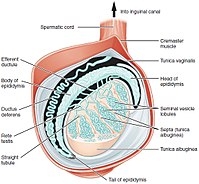
Photo from wikipedia
Introduction Open hydrocelectomy via scrotal incision is the standard approach for secondary hydroceles. Traditionally, the Swiss urologic community offer hydrocelectomy with additional resection of the epididymis in elderly men with… Click to show full abstract
Introduction Open hydrocelectomy via scrotal incision is the standard approach for secondary hydroceles. Traditionally, the Swiss urologic community offer hydrocelectomy with additional resection of the epididymis in elderly men with completed family planning. It is believed that the additional resection of the epididymis reduces the postoperative recurrence rate of hydroceles. However, there is no evidence supporting this theory. Therefore, the aim of this study was to compare the recurrence and complication rates for patients with secondary hydroceles undergoing either pure hydrocelectomy (puH) or hydrocelectomy with additional resection of the epididymis (HRE). Materials and Methods We reviewed all male patients who underwent surgical therapy for secondary hydroceles between May 2003 and February 2019 at our institution. Patient's baseline and perioperative characteristics as well as postoperative characteristics including complications and recurrence rates were gathered and compared between different surgical techniques. Results A total of 234 patients were identified. puH was performed in 93 (40%) cases and HRE in 141 (60%) patients. Patients in the HRE group were older (median age: 62 vs. 38 years, p < 0.001), had a higher ASA-Score (p < 0.001), were more often on platelet aggregation inhibitors (19% vs. 7.5%, p = 0.01), and had a longer median operative time (75 vs. 64 min, p < 0.001). During a median follow-up of 46 months, a similar number of recurrent hydroceles were found for puH (7 [7.5%]) and HRE (6 [4.5%]) (p = 0.3). Complications were observed in 19 (20%) cases after puH compared to 25 (18%) cases after HRE (p = 0.6). Patients after puH experienced more often severe complications (Clavien-Dindo Grade 3b) compared to the HRE group (5 vs. 12%, p = 0.046). Conclusion puH and HRE showed similar results in terms of overall low recurrence rates and also in terms of postoperative complications, even though patients who underwent puH experienced slightly higher severe complications. Both procedures are safe and effective, but it seems that HRE does not provide a relevant clinical benefit in comparison to puH for the management of men with secondary hydroceles.
Journal Title: Urologia Internationalis
Year Published: 2022
Link to full text (if available)
Share on Social Media: Sign Up to like & get
recommendations!